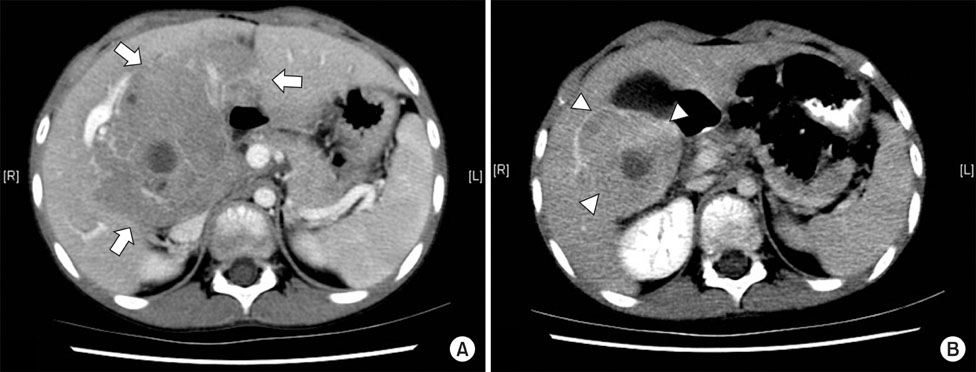J Korean Surg Soc.
2011 Aug;81(2):134-140. 10.4174/jkss.2011.81.2.134.
Hepatoblastoma: 15-year experience and role of surgical treatment
- Affiliations
-
- 1Division of Pediatric Surgery, Department of Surgery, Samsung Medical Center, Sungkyunkwan University School of Medicine, Seoul, Korea. sukkoo.lee@samsung.com
- KMID: 2096668
- DOI: http://doi.org/10.4174/jkss.2011.81.2.134
Abstract
- PURPOSE
Hepatoblastoma is the most common malignant liver tumor in children. The aim of this study was to review our results of hepatoblastoma treatment and to determine the role of surgical treatment in hepatoblastoma.
METHODS
This is a retrospective clinical study. The medical records of patients with hepatoblastoma, treated between October 1994 and October 2009, were reviewed. The patients were classified according to the pretreatment extent of disease (PRETEXT) grouping system. The main outcome variable was survival. Secondary outcome variables were complete, partial and no response to chemotherapy and surgery, when indicated.
RESULTS
Twenty-seven patients were treated during the observation period. Eighteen were males. Five were PRETEXT group I, 8 group II, 13 group III and 1 group IV. Complete excision was achieved in all patients except in one case that underwent liver transplantation (group IV). Median follow-up and survival rate were 2.3 years and 100%, 6.6 years and 75%, 5.8 years and 92%, 7.7 years and 100%, for groups I to IV, respectively. Twenty patients are currently considered to be in complete response status and three patients are receiving postoperative chemotherapy. Four patients died; the causes of death were cytomegalovirus hepatitis, bone marrow suppression during adjuvant chemotherapy, primarynonfunction after the transplantation for recurrent tumor and metachronous rectal cancer, respectively.
CONCLUSION
Favorable long-term outcome could be expected for hepatoblastoma with complete tumor excision and adjuvant chemotherapy.
Keyword
MeSH Terms
Figure
Reference
-
1. Brown J, Perilongo G, Shafford E, Keeling J, Pritchard J, Brock P, et al. Pretreatment prognostic factors for children with hepatoblastoma: results from the International Society of Paediatric Oncology (SIOP) study SIOPEL 1. Eur J Cancer. 2000. 36:1418–1425.2. Douglass EC, Reynolds M, Finegold M, Cantor AB, Glicksman A. Cisplatin, vincristine, and fluorouracil therapy for hepatoblastoma: a Pediatric Oncology Group study. J Clin Oncol. 1993. 11:96–99.3. Atkinson JB, DeUgarte DA. Grosfeld JL, O'Neill JA, Fonkalsrud EW, Coran AG, editors. Liver tumors. Pediatric surgery. 2006. 6th ed. Philadelphia: Mosby;502–514.4. Otte JB, Pritchard J, Aronson DC, Brown J, Czauderna P, Maibach R, et al. Liver transplantation for hepatoblastoma: results from the International Society of Pediatric Oncology (SIOP) study SIOPEL-1 and review of the world experience. Pediatr Blood Cancer. 2004. 42:74–83.5. Pritchard J, Brown J, Shafford E, Perilongo G, Brock P, Dicks-Mireaux C, et al. Cisplatin, doxorubicin, and delayed surgery for childhood hepatoblastoma: a successful approach: results of the first prospective study of the International Society of Pediatric Oncology. J Clin Oncol. 2000. 18:3819–3828.6. Aronson DC, Schnater JM, Staalman CR, Weverling GJ, Plaschkes J, Perilongo G, et al. Predictive value of the pretreatment extent of disease system in hepatoblastoma: results from the International Society of Pediatric Oncology Liver Tumor Study Group SIOPEL-1 study. J Clin Oncol. 2005. 23:1245–1252.7. Zsíros J, Maibach R, Shafford E, Brugieres L, Brock P, Czauderna P, et al. Successful treatment of childhood high-risk hepatoblastoma with dose-intensive multiagent chemotherapy and surgery: final results of the SIOPEL-3HR study. J Clin Oncol. 2010. 28:2584–2590.8. Sasaki F, Matsunaga T, Iwafuchi M, Hayashi Y, Ohkawa H, Ohira M, et al. Outcome of hepatoblastoma treated with the JPLT-1 (Japanese Study Group for Pediatric Liver Tumor) Protocol-1: a report from the Japanese Study Group for Pediatric Liver Tumor. J Pediatr Surg. 2002. 37:851–856.9. Suita S, Tajiri T, Takamatsu H, Mizote H, Nagasaki A, Inomata Y, et al. Improved survival outcome for hepatoblastoma based on an optimal chemotherapeutic regimen: a report from the study group for pediatric solid malignant tumors in the Kyushu area. J Pediatr Surg. 2004. 39:195–198.10. Meyers RL, Rowland JR, Krailo M, Chen Z, Katzenstein HM, Malogolowkin MH. Predictive power of pretreatment prognostic factors in children with hepatoblastoma: a report from the Children's Oncology Group. Pediatr Blood Cancer. 2009. 53:1016–1022.11. Otte JB. Progress in the surgical treatment of malignant liver tumors in children. Cancer Treat Rev. 2010. 36:360–371.12. Browne M, Sher D, Grant D, Deluca E, Alonso E, Whitington PF, et al. Survival after liver transplantation for hepatoblastoma: a 2-center experience. J Pediatr Surg. 2008. 43:1973–1981.13. Cillo U, Ciarleglio FA, Bassanello M, Brolese A, Vitale A, Boccagni P, et al. Liver transplantation for the management of hepatoblastoma. Transplant Proc. 2003. 35:2983–2985.14. Srinivasan P, McCall J, Pritchard J, Dhawan A, Baker A, Vergani GM, et al. Orthotopic liver transplantation for unresectable hepatoblastoma. Transplantation. 2002. 74:652–655.15. Aretz S, Koch A, Uhlhaas S, Friedl W, Propping P, von Schweinitz D, et al. Should children at risk for familial adenomatous polyposis be screened for hepatoblastoma and children with apparently sporadic hepatoblastoma be screened for APC germline mutations? Pediatr Blood Cancer. 2006. 47:811–818.16. Phillips M, Dicks-Mireaux C, Kingston J, Malone M, Mitchell C, Pritchard J, et al. Hepatoblastoma and polyposis coli (familial adenomatous polyposis). Med Pediatr Oncol. 1989. 17:441–447.17. Thomas D, Pritchard J, Davidson R, McKiernan P, Grundy RG, de Ville de Goyet J. Familial hepatoblastoma and APC gene mutations: renewed call for molecular research. Eur J Cancer. 2003. 39:2200–2204.
- Full Text Links
- Actions
-
Cited
- CITED
-
- Close
- Share
- Similar articles
-
- The results of combined therapeutic modalities for hepatoblastoma
- A Case of Successful Hepatic Resection after Local Radiotherapy with Combined Transarterial Chemoinfusion in Hepatoblastoma
- A Case of Hepatoblastoma
- 1 Case of chromosome 1q deletion with sialoblastoma and hepatoblastoma in neonate
- A Case of Living Donor Liver Transplantation for Unresectable Hepatoblastoma



